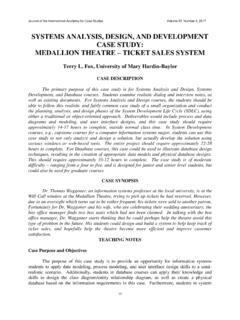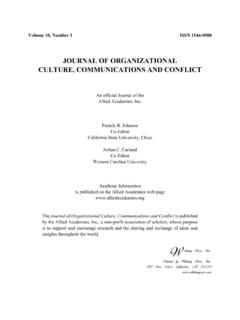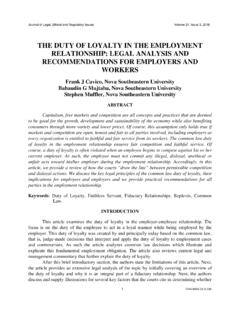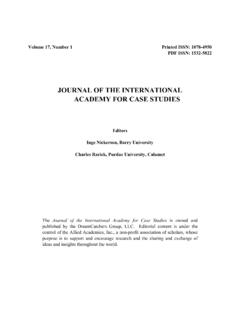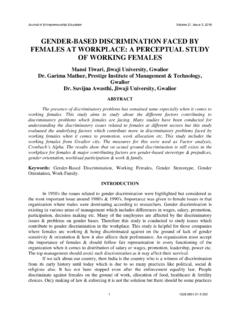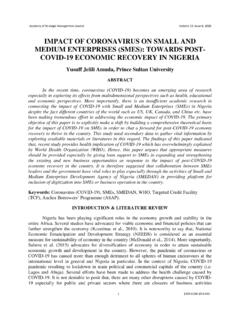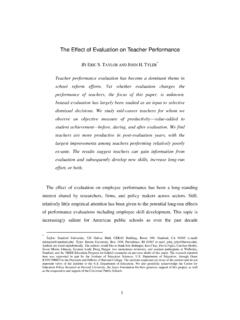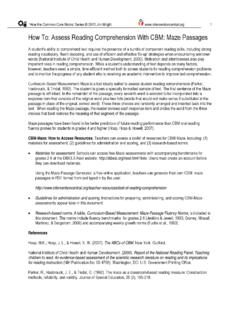Transcription of THE IMPACT OF TOTAL QUALITY MANAGEMENT (TQM) ON ...
1 Academy of Strategic MANAGEMENT Journal Volume 17, Issue 2, 2018 1 1939-6104-17-2-193 THE IMPACT OF TOTAL QUALITY MANAGEMENT (TQM) ON COMPETITIVE ADVANTAGE: A CONCEPTUAL mixed METHOD STUDY IN THE MALAYSIA LUXURY HOTEL INDUSTRIES Sin Kit Yeng, University Malaysia Perlis Muhammad Shahar Jusoh, University Malaysia Perlis Noormaizatul Akmar Ishak, University Malaysia Perlis ABSTRACT The widespread use of TQM has impacted the hotel industry worldwide and increasingly identified as the key issue in differentiating service products and building competitive advantage in tourism. Accordingly, hotel industries may face a wide variety of saturated and uncertain TQM practices available for their organization nowadays.
2 As there is a lack of comprehensive knowledge regarding TQM issues in hotel industry, there is an urgent need for a process which will assist hotel industries in Malaysia to evaluate these TQM practices and select the most appropriate one in order to provide the ideal MANAGEMENT practices for the entire organization. As such, this study will propose a mixed method study where 10 hotel managers are initially interviewed, followed by a quantitative study of 122 additional managers. The aim of this study is to assist the hoteliers for identifying the proper TQM practices and then evaluating the available practices that best fitted the hotel industry in Malaysia which could concomitantly help the Ministry of Tourism and Culture (MOTAC) to achieve its National Key Economic Area (NKEA) and contributing towards high nation income in 2020.
3 Keywords: TQM, Competitive Advantage, Hotel, mixed Method. INTRODUCTION Malaysia hotel industry especially luxury hotel industries are undergoing a challenging time because of stiff and intense competition from other hotels such as Airbnb, as well as heritage and budget hotels (The Borneo Post, 2017). Additionally, excessive hotel projects have saturated the market, with many more in the process of being constructed or about to be built, making the cutting-throat situation worst (The Star Online, 2017). The hotel market is pretty saturated at the moment and with more hotels opening, the demand for rooms is going to drop even further (The Metro News, 2017). In fact, due to the excessive supply of rooms as the number of Airbnb, budget hotels and guest-houses continued to increase significantly, it can be seen that hotels under the Malaysian Association of Hotels is either seeing stagnant or declining in terms of occupancy rates (Malaysia Tourism Statistics, 2016).
4 The way in which hotels gain a competitive edge falls into two main categories: price based, by establishing a low-cost MANAGEMENT through discounting; and QUALITY based, by providing customers with a unique experience to achieve customer loyalty (Ooi, 2014). Although low-cost MANAGEMENT through discounting helps increase a hotel s market share in the short term, it may negatively IMPACT on profitability in the long term (Maslanka-Wieczorek, 2014). Many hotels therefore have turned to Academy of Strategic MANAGEMENT Journal Volume 17, Issue 2, 2018 2 1939-6104-17-2-193 QUALITY improvement for achieving a competitive advantage marketplace (Dimanche, 2014).
5 Meanwhile, correct implementation of TQM practices could enhance the QUALITY of products/services delivered and enable hotels to remain competitive (Ho, 2010). LITERATURE REVIEW Introduction to TQM It is both a philosophy and a series of guiding justifications that are the basis of a ceaselessly improving organization (Shweta Bajaj, Ruchi Garg & Monika Sethi, 2018). It intends to accomplish the effectiveness of the system such as production, design, planning, QUALITY tools, techniques involvement as well as customer satisfaction as it has potential not only to reinforce competitiveness but also to strengthen firm effectiveness and produce more satisfied customers (Khanam, Siddiqui & Talib, 2015). In order to ensure definition of TQM to be valid especially in hotel sectors which connects not only customers but also other stakeholders, it must encompass the meaning of conformance to internal specifications which are predetermined and required by customers ( lkay & Aslan) and fulfill the continuously changing requirements of both the organization customer and stakeholders (Fotopoulos & Psomas, 2010).
6 Hence, the current study proposes a new definition of TQM mainly drawn from Ismyrlis et al. (2015); Aranda et al. (2015) stated as following: TQM is a MANAGEMENT based approach with the participation of all members of an organization in improving processes, products, services and the culture in order to achieve higher level of satisfaction of customers and other associated stakeholders. Elements of TQM There is no particular agreement on the elements that constitute TQM and still the elements are varying among different researchers across the globe (Corredor & Goni, 2011). What s more, use of different terminology in the context of TQM elements is raising the difficulty of comparing sets of elements since the terms elements, principles, components, factors and criteria seem to be employed interchangeably (Ahmad, Zakuan, Jusoh, Yusof, Takala & Arif, 2014).
7 Motivated by this conclusion, it is recommended that the TQM elements to be standardized so that a sound comparison can be made (Calvo-Mora, Picon, Ruiz & Cauzo, 2014). Additionally, synonyms of the TQM elements may cause redundancies (Delic, Radlovacki, Kamberovic, Maksimovic & Pecujlija, 2014) hence it is essential for similar elements to be combined into one category of elements for this study as shown in Table 1. To boot, there are TOTAL eight heterogeneous TQM elements after similar elements are being combined into one category of elements which constitute of leadership, strategic planning, supplier s QUALITY MANAGEMENT , process MANAGEMENT , product and service design, employee MANAGEMENT , customer relationship MANAGEMENT as well as information and analysis.
8 Academy of Strategic MANAGEMENT Journal Volume 17, Issue 2, 2018 3 1939-6104-17-2-193 Table 1 HETEROGENEOUS OF TQM ELEMENTS TQM Elements Other Terms Supporting References Leadership Leadership and MANAGEMENT commitment Barouch et al. (2016) Top MANAGEMENT support Mahmood et al. (2015) Leadership Frolova et al. (2015) MANAGEMENT leadership Kivipold et al. (2013) MANAGEMENT commitment Abdullah & Tar (2012) Top MANAGEMENT /Leadership Elshaer et al. (2016) Strategic planning QUALITY system Lakhal et al. (2006) Benchmarking Sit et al. (2009) Supplier's QUALITY MANAGEMENT Supplier's QUALITY MANAGEMENT Sadikoglu et al. (2014) Supplier MANAGEMENT Mosadeghrad (2015) Supplier relationship Abdallah (2013) Supplier QUALITY Jaafreh et al.
9 (2012) Supplier focus Mellat-Parast (2013) Supplier involvement Zakuan et al. (2010) Process MANAGEMENT Process MANAGEMENT Kafetzopoulos et al. (2015) Continuous improvement process Sadikoglu & Zehir (2010) QUALITY culture Ooi (2014) Statistical and QUALITY tools Wu (2015) Product and service design Product/Process design Shan et al. (2013) Design MANAGEMENT Jayaram et al. (2012) Product/Service design Kima et al. (2012) Employee MANAGEMENT Employee involvement Parast et al. (2011) Human resource focus Loke et al. (2011) Employee relation Jaafreh et al. (2012) Customer relationship MANAGEMENT Customer focus Yusr et al. (2014) Customer relations Kima et al. (2012) Information and analysis Information and analysis Mahmood et al. (2015) Leadership Many studies support that leadership is one of the most important factors that IMPACT a firm s performance (Ooi, 2014).
10 Leadership and top MANAGEMENT support is expected to have an integral role in encouraging the practices and behaviors that lead to QUALITY goals establishment, resources allocation, QUALITY performance evaluation and QUALITY improvement (Barouch et al., 2016; Alidrisi & Mohamed, 2012). Furthermore, the leader of a firm is responsible for creating the appropriate environment/culture for innovation besides cultivating the innovation process, QUALITY , finance MANAGEMENT and aligning the current strategy with the innovation strategy in order to achieve innovative and competitive performance (Frolova et al., 2015). Strategic Planning Strategic planning refers to the development and subsequent deployment of plans to forge a stronger tie with customers, suppliers and business partners (Baird, Hu & Reeve, 2011).
